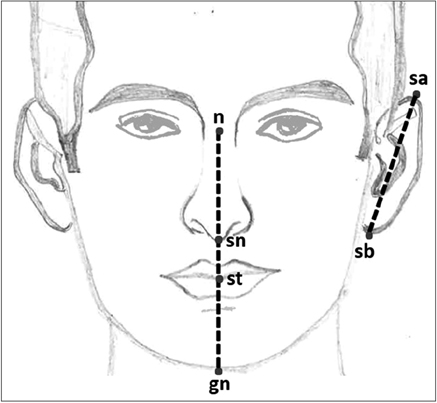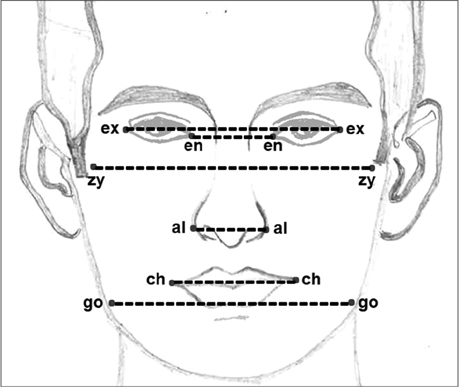Anat Cell Biol.
2016 Jun;49(2):125-131. 10.5115/acb.2016.49.2.125.
Vertical and horizontal facial proportions of Indian American men
- Affiliations
-
- 1Department of Anatomy, School of Medicine, American University of Antigua (AUA), Antigua, West Indies. smarx@auamed.net
- KMID: 2308919
- DOI: http://doi.org/10.5115/acb.2016.49.2.125
Abstract
- The importance of understanding all gender facial differences is critical in providing a successful cosmetic outcome. Men are a growing segment of the cosmetic industry. Understanding of the male face and its appropriate treatment with minimally invasive cosmetic procedures are essential. The aim was to investigate various facial ratios in Indian American men and to compare them with the Indian and Caucasian norms. Additionally, we wanted to evaluate whether these values satisfy golden and silver ratios. Direct facial anthropometric measurements were made using a digital caliper in 100 Indian American men students (18-30 years) at the American University of Antigua (AUA), Antigua. A set of facial ratios were calculated and compared with coefficients of variation (CV). Most of the facial ratios had small CV thus making them highly reliable due to reduced intra-sample variability. The upper face to face height and mandibulo upper face height indices were close to golden ratios whereas mandibulo lower face height, upper face height biocular width, and nasal indices were close to silver ratios. There was significant difference in most of the values when compared with previous studies. The present facial ratios data can be used as a reference value for Indian American men.
Figure
Reference
-
1. George RM. Anatomical and artistic guidelines for forensic facial reconstruction. In : Iscan MY, Helmer RP, editors. Forensic Analysis of the Skull. New York: Wiley-Liss;1993. p. 215–227.2. Keaney T. Male aesthetics. Skin Therapy Lett. 2015; 20:5–7.3. Bashour M. History and current concepts in the analysis of facial attractiveness. Plast Reconstr Surg. 2006; 118:741–756.4. Baker BW, Woods MG. The role of the divine proportion in the esthetic improvement of patients undergoing combined orthodontic/orthognathic surgical treatment. Int J Adult Orthodon Orthognath Surg. 2001; 16:108–120.5. Rossetti A, De Menezes M, Rosati R, Ferrario VF, Sforza C. The role of the golden proportion in the evaluation of facial esthetics. Angle Orthod. 2013; 83:801–808.6. Naini FB, Gill DS. Facial aesthetics: 1. Concepts and canons. Dent Update. 2008; 35:102–104.7. Jefferson Y. Facial beauty: establishing a universal standard. Int J Orthod Milwaukee. 2004; 15:9–22.8. American Society of Plastic Surgeons. American Society of Plastic Surgeons Releases report showing shift in procedures [Internet]. Arlington Heights, IL: American Society of Plastic Surgeons;cited 2016 Apr 1. Available from: http://www.plasticsurgery.org/news/2016/new-statistics-reflect-the-changing-face-of-plasticsurgery.html.9. American Society of Plastic Surgeons. American Society of Plastic Surgeons reports cosmetic procedures increased 3 percent in 2014 [Internet]. Arlington Heights, IL: American Society of Plastic Surgeons;cited 2016 Apr 1. Available from: http://www.plasticsurgery.org/news/2015/plastic-surgery-statistics-shownew-consumer-trends.html.10. Kalha AS, Latif A, Govardhan SN. Soft-tissue cephalometric norms in a South Indian ethnic population. Am J Orthod Dentofacial Orthop. 2008; 133:876–881.11. Jagadish Chandra H, Ravi MS, Sharma SM, Rajendra Prasad B. Standards of facial esthetics: an anthropometric study. J Maxillofac Oral Surg. 2012; 11:384–389.12. Anand S, Tripathi S, Chopra A, Khaneja K, Agarwal S. Vertical and horizontal proportions of the face and their correlation to phi among Indians in Moradabad population: a survey. J Indian Prosthodont Soc. 2015; 15:125–130.13. Sadacharan CM. Evaluation of various facial anthropometric proportions in Indian American women. Rev Argent Anat Clin. 2016; 8:10–17.14. Sadacharan CM. Facial proportions of Indian Americans and its clinical applications. MOJ Anat Physiol. 2015; 1:00020.15. Sadacharan CM. Orbitofacial assessment of the Indian Americans and its significance: an anthropometric study. MOJ Anat Physiol. 2015; 1:00018.16. Farkas LG, Katic MJ, Forrest CR, Alt KW, Bagic I, Baltadjiev G, Cunha E, Cvicelová M, Davies S, Erasmus I, Gillett-Netting R, Hajnis K, Kemkes-Grottenthaler A, Khomyakova I, Kumi A, Kgamphe JS, Kayo-daigo N, Le T, Malinowski A, Negasheva M, Manolis S, Ogetürk M, Parvizrad R, Rösing F, Sahu P, Sforza C, Sivkov S, Sultanova N, Tomazo-Ravnik T, Tóth G, Uzun A, Yahia E. International anthropometric study of facial morphology in various ethnic groups/races. J Craniofac Surg. 2005; 16:615–646.17. Farhadian JA, Bloom BS, Brauer JA. Male Aesthetics: a review of facial anatomy and pertinent clinical implications. J Drugs Dermatol. 2015; 14:1029–1034.18. Ferring V, Pancherz H. Divine proportions in the growing face. Am J Orthod Dentofacial Orthop. 2008; 134:472–479.19. Kiekens RM, Kuijpers-Jagtman AM, van't Hof MA, van't Hof BE, Maltha JC. Putative golden proportions as predictors of facial esthetics in adolescents. Am J Orthod Dentofacial Orthop. 2008; 134:480–483.20. Farkas LG. Anthropometry of the head and face. 2nd ed. New York: Raven Press;1994.21. Budai M, Farkas LG, Tompson B, Katic M, Forrest CR. Relation between anthropometric and cephalometric measurements and proportions of the face of healthy young white adult men and women. J Craniofac Surg. 2003; 14:154–161.22. Edler R, Agarwal P, Wertheim D, Greenhill D. The use of anthropometric proportion indices in the measurement of facial attractiveness. Eur J Orthod. 2006; 28:274–281.23. Farkas LG, Cheung G. Orbital measurements in the presence of epicanthi in healthy North American Caucasians. Ophthalmologica. 1979; 179:309–315.24. Raschke GF, Rieger UM, Peisker A, Djedovic G, Gomez-Dammeier M, Guentsch A, Schaefer O, Schultze-Mosgau S. Morphologic outcome of bimaxillary surgery: an anthropometric appraisal. Med Oral Patol Oral Cir Bucal. 2015; 20:e103–e110.25. Wankhede KP, Kamdi NY, Parchand MP, Anjankar VP, Bardale RV. Estimation of stature from maxillo-facial anthropometry in a central Indian population. J Forensic Dent Sci. 2012; 4:34–37.26. Kunjur J, Sabesan T, Ilankovan V. Anthropometric analysis of eyebrows and eyelids: an inter-racial study. Br J Oral Maxillofac Surg. 2006; 44:89–93.
- Full Text Links
- Actions
-
Cited
- CITED
-
- Close
- Share
- Similar articles
-
- The Effect of Vertical Transposition of Horizontal Muscles on Vertical Deviation Associated with Horizontal Strabismus
- Evaluation of factors influencing the change of vertical dimension of face after orthodontic treatment
- Cephalometric study of the effect of cervical pull headgear based on facial growth patterns
- Horizontal Ratio of the Korean University Student's Face and Facial Golden Mask
- The Utility of a Three-Dimensional Approach with T-Shaped Osteotomy in Osseous Genioplasty




